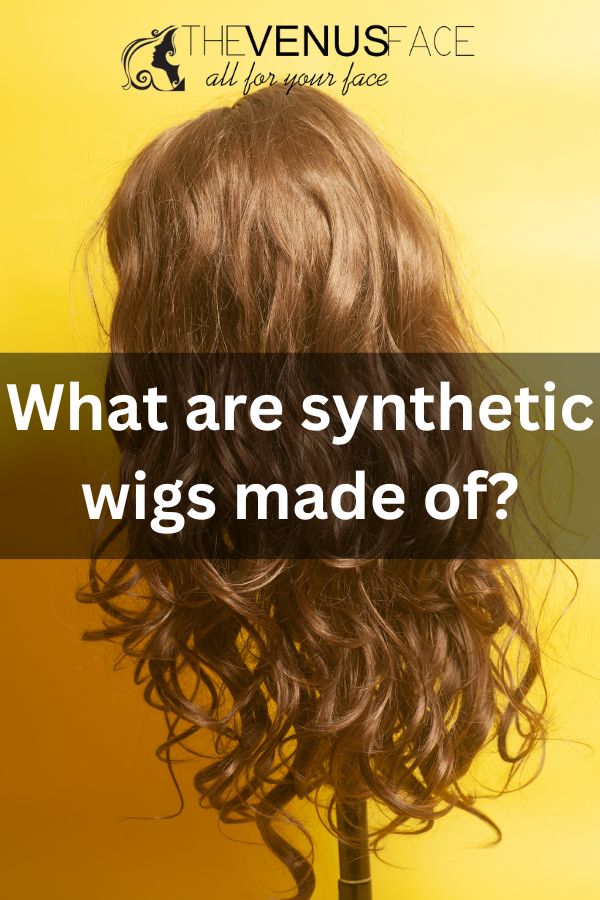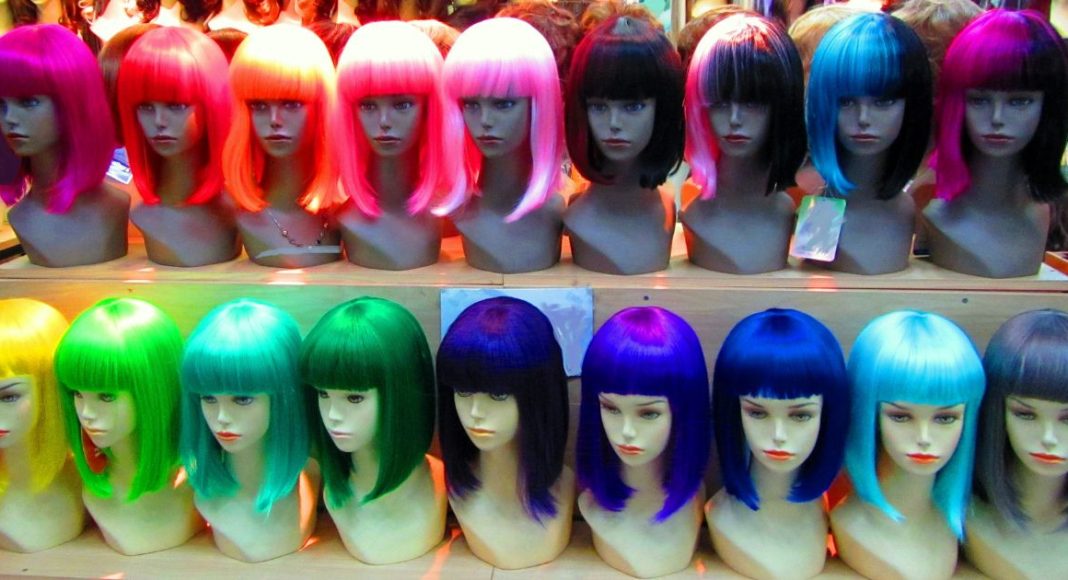Synthetic wigs have become really popular as an easy alternative to natural hair wigs, giving people a cost-effective option for trying out different styles. These wigs are made from synthetic fibers that are specially designed to look and feel like real human hair. In this discussion, we’re going to take a closer look at synthetic wigs, breaking down the materials that make them and getting to know what makes them unique in the world of hair accessories. We’ll explore how synthetic wig technology has evolved and talk about the perks that make them a standout choice for those who want both style and practicality.

What are synthetic wigs made of?
Synthetic wigs are typically made from synthetic fibers, with popular materials including modacrylic, Kanekalon, Toyokalon, acrylic, polyvinyl chloride (PVC), PBT, polyester (PET), and polypropylene. These fibers are chosen for their durability, affordability, and the ability to mimic the look and feel of natural hair. Some synthetic wigs may also contain additives like ultrafine ground glass fiber or cubical boron nitride to enhance their properties.
Specific Materials and Their Characteristics
Synthetic wigs boast a diverse range of materials, each contributing distinct characteristics to the overall quality and performance of the wig. Understanding the unique properties of these materials is crucial for consumers seeking the perfect synthetic wig for their needs.
Acrylic
Description: Acrylic, a prevalent material in synthetic wigs, is a type of plastic known for its lightweight and soft texture.
Properties: It mimics the natural shine and movement of human hair, providing a realistic appearance. However, its drawback lies in its susceptibility to heat, which can limit styling options.
PVC (Polyvinyl Chloride)
Description: PVC, another common synthetic wig material, is a thermoplastic with a wide range of applications.
Properties: PVC adds durability to the wig, making it resistant to wear and tear. It is also a cost-effective option, but it may lack the softness and natural feel of other materials.
PBT (Polybutylene Terephthalate)
Description: PBT is a synthetic polymer often used in combination with other materials.
Properties: Its inclusion enhances the wig’s heat resistance and helps maintain its shape. PBT is recognized for its excellent dye-retaining capabilities, ensuring vibrant and long-lasting colors in synthetic wigs.
Polyester (PET)
Description: Polyester, or PET, is a synthetic fiber widely used in various applications, including wig manufacturing.
Properties: It offers a good balance of durability, affordability, and heat resistance. Polyester contributes to the overall strength of the wig, making it a reliable choice for everyday wear.
Polypropylene
Description: Polypropylene stands out for its exceptional heat resistance and versatility.
Properties: Its resistance to high temperatures allows for more styling options without compromising the wig’s structural integrity. Polypropylene is especially crucial for those who prefer heat-styling methods, such as curling or straightening, providing a level of flexibility not always found in other synthetic wig materials.
Polypropylene’s standout feature is its resistance to heat, making it a game-changer in the realm of wig styling. Unlike some other materials that may be prone to damage or deformation when exposed to heat, polypropylene allows for the use of heated styling tools. This means wearers can confidently experiment with various hairstyles, including curls, waves, and straight looks, without compromising the wig’s overall quality.
The significance of polypropylene becomes evident in its ability to withstand the styling process, providing users with the freedom to express their creativity and adapt their synthetic wigs to different occasions. Whether for daily wear or special events, the heat resistance of polypropylene opens up a world of styling possibilities, elevating the overall experience for individuals seeking versatility and convenience in their synthetic wigs.
More: Can You Bleach Synthetic Wigs? How to Do It Properly?
Considerations for Wig Styling
Styling synthetic wigs is an art that requires a nuanced understanding of the materials used in their construction. The importance of heat resistance in synthetic wigs cannot be overstated, as it directly impacts the versatility and longevity of the wig. Here’s an in-depth exploration of key considerations for wig styling:
Importance of Heat Resistance
The significance of heat resistance cannot be overstated, particularly synthetic wigs where individuals often revel in the exploration of diverse hairstyles. Materials characterized by heightened heat resistance, exemplified by substances like polypropylene, offer a crucial advantage by permitting the use of heated styling tools such as curling irons and straighteners. Beyond mere versatility, the enduring quality of wigs capable of withstanding heat emerges as a pivotal factor influencing their longevity. The capacity to effortlessly restyle the wig without incurring damage not only enhances its durability but also guarantees wearers the pleasure of sporting a rejuvenated appearance for an extended period, underscoring the paramount importance of heat resistance in the realm of wig selection.
Tips and Best Practices for Styling Synthetic Wigs
Temperature Control: When using heated styling tools, it’s crucial to set them at a moderate temperature. Excessive heat can cause irreversible damage to synthetic fibers, leading to melting or distortion.
Pre-Styling Care: Before styling, detangle the wig using a wide-tooth comb. Applying a heat protectant spray can also create a protective barrier, minimizing the impact of heat on the wig’s fibers.
Experiment with Low Heat Settings: Start with a lower heat setting and gradually increase if needed. Some synthetic wigs respond well to lower temperatures, allowing for styling without compromising the integrity of the fibers.
Addressing Common Concerns
Understanding the specific material composition of the synthetic wig is key to effective styling. Different materials have varying heat tolerances, and this knowledge empowers users to make informed decisions when choosing styling methods.
Melting and Deformation: Lower-quality synthetic wigs or those made from materials with poor heat resistance may experience melting or deformation under high temperatures. It’s essential to check the wig’s care instructions and adhere to recommended heat levels.
Color Fading: Intense heat exposure can lead to color fading in synthetic wigs. To preserve vibrant colors, avoid prolonged exposure to direct sunlight or excessive heat.
Avoiding Friction: Friction, whether from frequent styling or contact with rough surfaces, can cause synthetic fibers to lose their sheen and become prone to tangling. Minimize friction by handling the wig gently and storing it properly when not in use.
Variability Among Synthetic Wig Products
Synthetic wigs, despite sharing a common purpose, exhibit considerable variability in their material composition across different brands and products. This diversity in materials and proportions not only shapes the wig’s overall quality but also provides consumers with a spectrum of options to align with their unique preferences and needs.
Diverse Material Choices
Brand-Specific Formulas: Various brands have proprietary formulas for synthetic wig construction, often combining different materials in distinct proportions. These formulas contribute to the unique characteristics and performance of each brand’s wig.
Innovative Material Blends: Some brands experiment with innovative material blends, incorporating advanced fibers or additives to enhance specific features, such as softness, heat resistance, or color retention.
Importance of Consumer Awareness
First off, not all synthetic wigs are cut from the same cloth. Knowing the lowdown on the materials different brands use is gold for folks who care about stuff like durability, that natural look, or being able to style their wig like a pro.
But here’s the kicker – dodging those tricky marketing claims. Being aware of material differences is like having a superpower against misleading ads. Some brands might shout from the rooftops about their materials or features, and a consumer armed with knowledge can sift through the noise. It’s all about figuring out if those claims match up with what you’re after. So, next time you’re eyeing a new wig, remember: being clued in isn’t just cool; it’s your secret weapon against getting hoodwinked by flashy marketing.
Informed Purchasing Decisions
Knowing the nitty-gritty of wig materials is like having the ultimate cheat code for smart shopping. Take heat styling fanatics, for example; they’d probably vibe with wigs rocking high heat-resistant materials like polypropylene. On the flip side, if you’re all about that natural, easy-breezy look, there are materials out there that tick that box.
Now, onto the dollars and cents of it all – because budget matters, right? Understanding these material nuances isn’t just about style; it’s about making choices that won’t break the bank. Some materials are wallet-friendly without skimping too much on quality, making them the go-to for savvy shoppers who want their wig game strong without blowing the budget. It’s all about knowing the ropes and making choices that not only look good but also feel right for your wallet.
Diversity in Materials for Individual Preferences
It’s all about style customization – from glossy finishes to a feather-light feel or popping color vibrancy, the diverse range of materials ensures there’s a wig to match every vibe.
Now, let’s talk comfort and longevity because, hey, we’ve all got specific needs. If you’re all about that breathable, lightweight life, there’s a material for that. And for those eyeing wigs that stand the test of time, materials resistant to wear and shape-shifting over the long haul are up for grabs.
The sheer variety in synthetic wig offerings is like a backstage pass to the dynamism within the industry. Consumers get to play the role of the casting director, choosing from a lineup of options that align with their unique preferences. To nail that perfect match, it’s crucial to dig into the nitty-gritty of each wig’s material composition. This ensures that your chosen synthetic wig not only ticks the boxes for immediate needs but also aligns with your long-term expectations for top-notch quality and performance. It’s a material world, and your wig should fit right into it.
Industry Trends and Innovations
The synthetic wig industry, much like other sectors, is subject to continuous evolution and innovation. As technology advances and consumer preferences shift, new trends in synthetic wig materials emerge, driving research and development within the industry. Here is a detailed exploration of the current landscape:
Emerging Trends in Synthetic Wig Materials
Bio-Based Materials: A notable trend in recent years is the exploration of bio-based materials for synthetic wigs. Some manufacturers are experimenting with sustainable and eco-friendly materials derived from plant sources, offering an alternative to traditional synthetic fibers.
Advanced Polymer Blends: Ongoing research has led to the development of advanced polymer blends, combining traditional synthetic fibers with newer, high-performance polymers. These blends aim to enhance the overall quality, durability, and styling versatility of synthetic wigs.
Ongoing Research and Development
Picture this: researchers are on a mission to amp things up by diving into nano-technology. Yeah, we’re talking about squeezing that mind-blowing nano-scale tech into the very fabric of synthetic wig materials. They’re throwing on nano-coatings to jazz up color retention, kick friction to the curb, and basically upgrade the whole vibe of the wig – making it look and feel top-notch.
About heat resistance – a total game-changer in the world of wig styling. There’s this ongoing hustle to cook up materials that can take the heat, literally. They’re aiming for formulas that can handle higher temperatures without leaving your wig in a melted mess. It’s all about keeping that structural integrity intact while turning up the heat on your styling game. The future of synthetic wigs? It’s looking seriously high-tech and seriously cool.
Impact on Quality, Durability, and Styling Options
Enhanced Realism: Innovations in materials contribute to more realistic-looking synthetic wigs. Advanced fibers and blends aim to replicate the texture, shine, and movement of natural human hair, providing wearers with an increasingly authentic appearance.
Increased Durability: Newer materials and manufacturing techniques focus on improving the overall durability of synthetic wigs. This includes increased resistance to wear, tear, and environmental factors, extending the lifespan of the wigs.
Expanded Styling Possibilities: As research progresses, the heat resistance and flexibility of synthetic wig materials continue to improve. This expansion in styling possibilities allows wearers to experiment with a broader range of hairstyles, including intricate curls, waves, and straight styles.
Consumer Impact and Adoption
Alright, so here’s the lowdown on consumer awareness in the world of synthetic wigs: it’s a game-changer. As these cutting-edge innovations take center stage, being in the know is key. Savvy consumers who’ve done their homework can navigate the synthetic wig scene like pros, making choices that match their style and priorities.
Now, let’s talk customization. The ongoing strides in synthetic wig materials give consumers the power to customize like never before. Whether you’re all about sustainability, craving next-level styling options, or just want a wig that can stand the test of time, the trends in the industry have got you covered. It’s all about catering to the diverse needs of wig enthusiasts, putting the spotlight on options and choices that scream individuality.
What are the 4 disadvantages of synthetic hair?
- Cannot be colored: Traditional hair dyes won’t adhere to synthetic fibers, and the chemicals can melt the wig.
- Limited styling options: Synthetic hair cannot be styled with heat, as it may cause the fibers to melt, tangle, and lose shape.
- Durability: Synthetic wigs and toppers do not last as long as human hair, leading to a shorter lifespan.
- Flammability: Synthetic fibers are highly flammable and non-resistant to heat, posing a potential safety risk.
Final thoughts
Synthetic wigs are a blend of various materials like acrylic, PVC, PBT, polyester, and polypropylene, with additional elements for specific enhancements. Polypropylene, known for its heat resistance, allows for versatile styling. Different brands use diverse materials, urging consumers to consider specifics when choosing wigs. Awareness of material differences is crucial to avoid issues and make informed decisions. The dynamic synthetic wig industry continuously improves quality, durability, and styling options through ongoing research and innovations. Consumers can anticipate a constant influx of new and enhanced products, aligning their choices with personal preferences for an ever-expanding range of options. As technology and research progress, the future promises even more exciting possibilities, emphasizing continuous improvement and innovation in the synthetic wig landscape.


